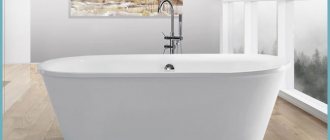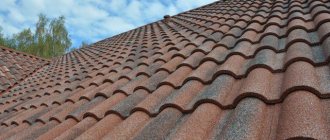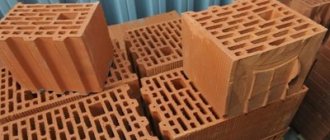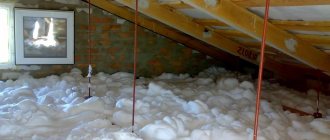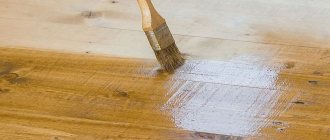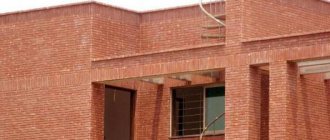The quality of the soil has a great influence on the choice of foundation and the entire construction technology in general.
In Russia there are a large number of problem regions where swampy, flooded or weak-bearing soil types predominate.
The use of a traditional foundation in such conditions is unacceptable, but pile types of support structures come to the rescue.
They ensure contact of the base with dense layers of soil and allow the construction of massive and heavy buildings without fear for their condition.
There are also lighter options for pile foundations, which include screw piles.
Foundation on screw piles
Screw piles are a supporting structure in the form of a system of metal pipes immersed in the ground with spiral blades welded at the bottom (photo below) . They play the role of cutting, similar to that done on screws.
The pointed conical tip allows the trunk to enter the ground more easily, and the blades perform the cutting function and in parallel serve as support units.
The submerged support is kept stationary due to the frictional force between the side walls of the pipe and the ground, as well as due to the load on the blades. The installation is carried out according to a certain scheme, forming the so-called. a pile field that ensures uniform load distribution across all shafts .
After immersion, the upper parts are trimmed to form a flat plane and tied with a load-bearing belt - a grillage.
It provides a supporting structure for the walls and evenly transfers the load to the pile system.
The functions of the grillage are close to the operation of a strip foundation, but the support for it is not the ground surface, but the upper ends of the vertical rods. To strengthen the structure, hollow pipes are filled with compacted concrete after installation, which makes them immune to possible lateral loads .
IMPORTANT!
Installation of screw piles does not require immersion until contact with dense layers of soil occurs. With sufficient depth, they quite reliably hold the building, being a hanging type of piles.
Factors that determine duration of use
The durability of the pile foundation being built, which has many positive aspects, depends on a number of factors that determine the service life of screw piles:
- Increased concentration of groundwater and nearby aquifers, which are the cause of corrosion destruction.
- Low acidity of the soil, which contributes to the weakening of supports as a result of corrosion.
- Significant temperature fluctuations causing a change in the volume of the metal structure with a subsequent violation of integrity.
- The presence of rocky inclusions in the soil, contact with which damages the protective coating.
- Violations of the technology of operations associated with penetration into the ground, which leads to the formation of scratches and damage to the protective layer.
- Shrinkage of the foundation of a building installed on weak soils, causing deformation of the supporting elements.
The supporting elements of a pile-screw foundation can be used for no more than 25-30 years without special protective measures. Subsequently, the piles are gradually destroyed. This reduces the strength of the foundation and the stability of the structure.
The price is too low and the lack of certificates is a reason to think about whether it’s worth buying them
Advantages and disadvantages
The advantages of screw piles include:
- High installation speed.
- Possibility of manual installation, which allows you to work in close proximity to finished buildings.
- The cost of screw piles is much lower than other types of foundation.
- Possibility of reuse. If necessary, the piles can be removed and used elsewhere.
- No excavation required for installation.
- It is possible to build on slopes or folds of the terrain.
- You can do without the use of complex equipment.
The disadvantages are:
- Operating conditions promote corrosion.
- The use of screw piles in regions with high seismic activity is prohibited.
- Immersion in rocky soil is not permitted.
- The use of screw piles on loose or weak-bearing soils that do not provide sufficient lateral support requires additional examination and clarification of the immersion depth.
Most of the shortcomings are often hushed up by manufacturers, so it is necessary to have a complete understanding of the properties and qualities of the design.
Summing up
And in conclusion, I would like to note that, knowing the whole truth about the service life of metal piles in fresh water and aggressive environments, you can build a truly reliable and durable foundation in a short period of time that will last for decades. The main thing is to follow the manufacturing process of supports and the installation technology of such building elements.
During operation, the foundation of any building is exposed to the harmful effects of moisture, low temperatures, stray currents and various aggressive environments. To prevent its possible destruction, developers must build a reliable foundation structure that can withstand negative factors. For areas with difficult soils and close proximity to groundwater, the ideal solution would be a screw foundation, which uses various rolled steel.
Types of supports
Let's consider what types of screw supports are used in modern construction:
By area of application
This type of foundation is used much more widely than it might seem at first glance.
Screw piles are successfully used in the following areas:
- Capital construction.
- Individual residential construction.
- Bridges, piers, other hydraulic structures.
- Load-bearing supports of power lines, masts, etc.
- Hangars.
- Greenhouses.
- Fences or enclosures, etc.
The rise in popularity of this type of base has greatly expanded the range of applications, and the process is not over yet..
Dimensions
Steel pipes of different diameters are used . The most common pipes are 108 mm; this size provides a fairly high load-bearing capacity with good penetration into the ground.
The general range of pipe diameters is between 57-219 mm, but in some cases thicker supports are used .
In private housing construction, pipes larger than 159 mm are not used due to the difficulty of immersion.
The length of the pipes also has many options . There are standard sizes from 1650 to 9000 mm, used in appropriate conditions.
The lower the strength and density of the soil, the longer the trunk should be.
Number of blades
There are single and multi-bladed designs. Single blades are used on relatively stable soils.
Exceeding the load or reversing the pile during installation leads to loss of adhesion to the ground.
For critical buildings on weak-bearing soils, multi-bladed piles are used, which demonstrate greater resistance to possible loads.
In addition, increasing the number of blades allows you to reduce the diameter of the barrel, which makes diving easier.
At the same time, the thickness of the walls must provide the necessary rigidity.
Tips
The tip takes on the load when immersed, which puts forward quite stringent requirements for its design.
Exist:
- Welded tips . They are made by narrowing the diameter of the pipe by removing wedge-shaped sections and connecting the resulting fragments into a cone. The seams are welded and a pointed end is formed. Used for relatively weak, soft soils.
- Cast tips . They are manufactured (cast) separately and attached to the pipe. They are thick and capable of destroying obstacles. Used on dense and difficult soils.
Material of manufacture
Different grades of steel are used - from the usual St 3 to the more durable St 20.
For use in highly aggressive soils with heavy loads and the possibility of electrostatic corrosion, durable steel grades 30 KhMA and 09G2S are used.
Type of protective coating
The most effective coating is considered to be a layer of zinc. At the same time, the material itself must be sufficiently resistant to corrosion .
Polymer materials applied to the piles are erased during immersion and cannot fulfill their task.
They are necessary only to protect the outer part of the supports and require periodic updating.
Many engineers offer their own protection options, from mastics to applying a layer of rubber, but these methods have not yet become widespread.
Checking the grounding system
When the installation is completed, you need to test the resistance of the ground loop. In accordance with the rules for electrical installations, the resistance indicator for an electrical network with a voltage of 220 Volts should not exceed 30 Ohms.
Measurements are carried out in dry weather (during such periods the greatest soil resistance is observed). If the measurement results are within the normal range, the trench with the grounding loop is covered with earth, after which the grounding is ready for operation.
Before proceeding with grounding a pile foundation, it is necessary to consult with energy supply specialists servicing the area on which the foundation is located. The experts will give recommendations regarding the correct preparation of calculations and selection of materials, and provide technical regulations.
Which ones are most optimal for use in country house construction?
It is impossible to name the optimal type of screw piles without analyzing the soil or calculating the weight of the house.
If we proceed from the specifics of the construction, which involves the creation of a relatively light house with a small number of floors, then the most appropriate option would be to use single-bladed trunks with a diameter of 57 to 108 mm, depending on the type and condition of the soil .
More detailed information will only be provided by surveying the site and calculating the load, since the pile has a certain limit. For example, with a diameter of 57 mm, the maximum load will be 800 kg .
What can reduce durability?
Factors that have a direct impact on the service life of a pile foundation:
- Mobility of land masses. On sites with unstable soil, horizontal and buoyant forces act on the piles, which lead to deformation of the pipes and, as a result, a decrease in wear resistance.
- Seasonal temperature changes . Metal tends to contract and expand under the influence of low and high temperatures. As a result, cracks appear in the coating, where moisture penetrates, causing corrosion. If there are large temperature differences in the region where the foundation is being built, it is economically feasible to purchase piles and high-strength alloy steel.
- Agrotechnical soil erosion . The negative effect is especially pronounced in areas with hilly terrain. The action of the factor leads to local cracking of the metal surface. The presence of small stones in the soil that scratch the outer coating increases the rate of destruction.
- Chemical corrosion . In soil with a high acidity level, rust formation occurs faster. The problem is solved by sandblasting the rod before immersing it in the soil.
- Exposure of metal to an electrically conductive environment . Currents wandering in the soil increase the rate of metal oxidation. Foundations next to which cables or industrial facilities are laid underground are more susceptible to negative effects.
- Failure to comply with transportation and storage rules, as well as violation of installation technology. The listed aspects lead to damage to the surface of the piles and thereby reduce the degree of protection from many external factors.
The service life of reinforced concrete screw piles depends, first of all, on the quality of the concrete used, as well as compliance with production technology. Such a foundation will last more than a hundred years if the permissible loads are correctly calculated and the alignment of the load-bearing elements at the same level is observed during the process of screwing into the ground.
For what buildings is it needed?
Screw piles can be used for various buildings. World practice has shown the ability of this type of foundation to successfully work with massive, heavy and tall buildings and structures.
However, in Russia the technology for creating this foundation has not yet been developed, so they are usually limited to the construction of auxiliary or outbuildings. For residential buildings, screw piles are used reluctantly and quite rarely.
Life time
Under ideal conditions (soil that does not have a destructive effect on the material, no corrosion, etc.), the support can last up to 300 years , and if there is a galvanized layer, up to 800 years.
This is what manufacturers and marketers say, although they have no basis for this. Not even 299 years have passed since the invention, so such statements cannot be taken seriously. Ideal conditions do not exist, and impacts and normal metal fatigue have not gone away .
Therefore, the real service life of such a foundation should be considered 50-75 years, although deviations in one direction or another are possible.
NOTE!
Some of the structures that were first built on screw piles by their inventor, Mitchell, are still standing and in use today.
Epoxy resins
This type of protection is widely practiced by manufacturers of finished piles. It has proven its effectiveness over many years of practice: its service life usually exceeds 50 years, which is quite enough for this type of foundation. This coating will not be scratched even by careless transportation or screwing (which, of course, should be avoided). Many people are interested in the question, what is the service life of such a product? If you improve the design by filling the “insides” of the pipe with concrete, then it can serve faithfully for over 100 years.
Is this a capital foundation or not?
Screw-in piles are capable of supporting very heavy and massive buildings or structures. Therefore, they should be considered a capital foundation by right.
In this matter, a certain psychological imbalance arises, since outwardly they do not look like a reliable support corresponding to the term “capital”.
However, the main feature is the permissibility of use in the construction of residential buildings.
This allows us to reasonably consider screw piles as a permanent type of foundation.
How to make the right choice?
The selection of screw piles consists of two stages:
- Determining the appropriate size and type of screw piles.
- Selection of specific products based on quality and compliance with requirements.
The first stage is almost entirely carried out during the design of the house. Therefore, there is no point in talking about it.
The second stage is usually carried out by representatives of the company with which the contract is concluded.
If for some reason you have to choose on your own, you should pay attention to the following details:
- The thickness of the pipe walls should not be less than 4 mm.
- The thickness of the blades is at least 5 mm.
- The quality of welding must be as high as possible.
- The presence of a galvanized layer.
- Tip type and quality.
Using these criteria, you can choose the best quality products.
IMPORTANT!
If any items do not meet the established requirements, it is better to refuse to purchase such piles.
Answer
Leave your tips and comments below. Subscribe to our newsletter. Good luck to you and good luck to your family!
- Question: Can a water well casing be used as a ground electrode?
- What is and how to do zeroing
- Question: We need a staircase to the second floor, there is not enough space
- What kind of foundation for a garage should be made from FBS blocks?
- How to insulate a bath
- What is the minimum slope of a gable roof for normal snow melting?
- How to make, build a fence from corrugated sheets with your own hands
- How to build a 10x20 m garage from a met sandwich. frame?
- Question: Which roof design is best for an extension?
- Question: There is no ventilation in the apartment, how can I do it?
- Load on the septic tank lid from cars passing over it
- Question: How to repair and insulate a roof
- How to navigate by the stars and moon
- Question: About waterproofing and flooring in a cellar on the river bank
- Vegetable storage in the basement (raise and insulate the walls, arrange ventilation)
- Siding frame for a house made of foam blocks
This can lead to accelerated wear of the piles due to increased corrosion, especially if there are current leaks to the ground. It is better to arrange a separate grounding.
How much does a foundation like this cost?
Let's consider the cost of a screw foundation for a small house 6:6 m. The optimal layout of a pile field consists of 9 piles.
Then the owner of the site will be required to pay for the installation of 9 pieces (cost from 650 to 1100 rubles / piece) and the price of the piles themselves.
It depends on the length and diameter - for example, VS-57 (diameter 57 mm) 3 meters long costs 1100 rubles with installation or 1200 without installation.
If you decide to use VS-108, then the price without installation (for a 3-meter trunk) will be 1150 rubles with installation and 1350 without installation. The difference in purchase price with and without installation is intended to encourage ordering installation from this company.
As a result, the cost of the foundation will be about 20,000 rubles. But this amount does not include delivery and other overhead costs, so it is necessary to have some reserve.
Prices at other companies may differ; this must be clarified directly on site..
Territories with permafrost zones
Considering the thickness of frozen rocks from the point of view of physical and mechanical properties, 3 zones are distinguished:
- Upper (cover) deposits containing ice in the bulk.
- Indigenous soil in a weathered area.
- Bedrock located in the zone of horizons under permafrost.
The definition of these zones has a great impact on obtaining survey results. The thickness of each VG area depends on two indicators - the geological structure and the local climate in:
- in mountainous areas with folded relief, the thickness of the upper zone of the VG varies from bottom to top of the relief from 1 – 3 m to 20 m;
- in the floodplains of some Siberian rivers, this value reaches from 100 to 200 m. In the floodplain of the Yana River (Yakutia), the thickness of the upper zone exceeds 200 m;
- In coastal areas of the East Siberian Sea, the thickness of the cover zone can be several hundred meters.
Carrying out survey work
Brief and general installation diagram
Procedure:
- Marking the pile field.
- Screwing piles.
- Filling the pipe cavities with concrete, trimming the tops to obtain a flat surface.
- Installation of headers.
- Installation of grillage.
It is recommended to carry out installation using special machines. This makes it possible to ensure verticality and the absence of rocking of the pile when screwing, which promotes maximum close contact with the ground . Welding areas and those damaged during the process are tinted with a protective anti-corrosion compound.
Protective measures
There are proven methods that can significantly increase the service life of screw piles:
- protection of the metal surface by applying hot zinc coating. The technology makes it possible to ensure the durability of the supports for 120 years;
- processing of piles using cold galvanizing, used with a minimum number of negative factors affecting the supports. The method provides short-term protection;
- filling the internal cavity of the pile with a concrete mixture that prevents corrosion destruction. The measures extend the service life of screw piles by 50 years;
- applying a protective layer to the surface, the basis of which is epoxy resins. The protective coating maintains integrity when screwed in and ensures sealing of the part located in the ground for more than 50 years;
- the use of polyurethane-based resins, which provide increased adhesion and form a reliable coating. Compliance with the technology of applying polyurethane resins, according to the manufacturers’ recommendations, ensures the durability of the supports for more than 50 years.
Remember that the intensive development of corrosion processes annually reduces the thickness of the metal by 30 microns, and the absence of oxygen simply slows down the intensity of corrosion.
To increase the service life of the pile foundation, it is necessary not to forget about treating the pipes with special compounds

